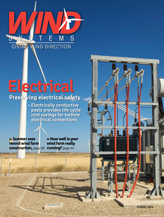Usually when I ask someone how their wind farm is running, they respond with an answer containing information related to the wind farm’s availability.
Sometimes there is mention of the wind farm capacity factor. Everyone seems to be happy if all their turbines are spinning and not one is down.
I’m of the opinion that the availability response is a great indication of how many hours the turbines brakes are released, allowing the turbine to spin. However, it’s not the best indicator as to how the wind farm is running. I think capacity factor answer is closer to the real indicator — although difficult to gauge on a daily basis.
Probably the best way to track how well your wind farm is running is to watch the turbines’ power curves. I mean, if you take just two turbines with the same availability, they won’t have the same power production in most instances. This is because we are able to adjust and improve each turbine’s operating performance individually.
Then again, we may find that both turbines are running at optimum efficiency for their individual locations. But you can’t tell that by “availability.”
In order to determine efficiency, you have to assess each turbine’s performance on an individual basis.
Let’s take a look at some of the factors that you — as a wind farm owner, operator, or technician — can control when it comes to a turbine’s power output.
The first of these determination factors — borrowing from my opening illustration — is the duration of the “brake release.” How long was the turbine actually allowed to spin?
This is followed by turbine orientation. Is the turbine responsive to wind direction changes? Is it pointed “dead-on,” directly into the wind? Or is it just good enough? How fast does your turbine react to minute changes in direction?
Next, look at the blade pitch. The controller says the blades are at optimum pitch, but have you confirmed actual blade pitch? There are often inconsistencies between the true blade pitch angle and the blade pitch marks on the blades. Are your blades balanced? How do you know? Rotors that are out of balance can result in production losses due to energy needed to raise the heavy side of the rotor. Correcting that rotor imbalance has the potential to improve a turbine’s power output.
The next factor you control is the condition of the blade airfoil surface. Dirt, smashed bug buildup, and general blade surface roughness can rob your turbine of production. Many sites have had experiences where the leading edges of the blades have eroded away.
In the turbine performance comparison process, you have two primary informational tools at your disposal — the wind turbine power curve and the wind occurrence matrix.
You’re likely familiar with power curve graphs that typically chart the power output vertically and the wind speed horizontally. Most turbines express their power curves with 10-minute averages. This 10-minute averaging is good for general review, but not the best for tracking issues as the smaller issues get smothered in the mix.
Taking a look at your wind occurrence data will tell you when your turbine is in operation the most. Although your turbine’s maximum output rating is typically part of the turbine size identifier, the turbine may spend minimal time producing power at that said rating. Instead, the turbine may spend the majority of its time producing power at a percentage of the its nameplate rating, due to periods when winds fall below the turbine’s wind speed rating.
A wind occurrence matrix tracks how many hours or minutes in a year the wind blows at a specific wind speed. You may find out that out of the 8,760 hours, the wind only blows at the rated wind speed or greater a few hundred hours a year. You may find that your site sees 5,000 hours at wind speeds that produce half of your turbine’s output rating. At this site, all of your efforts should be to grab as much power as possible during those most frequent hours.
Some sites may find that they are operating at or above the fleet’s wind speed rating the majority of the time. This type of site will find it difficult to perform maintenance services due to a lack of low-wind periods. However, that’s a good problem to have!
Reviewing your power curves in relation to your wind occurrence for each turbine can be time consuming, but is worthwhile. Rank all of your turbines from best to worst in terms of production. Then create a chart for each turbine using power curve data from as short of a duration as possible (or from a period that at the very least gives you some comparable data). From there, you can compare all of the turbines against each other using data from the same time frame.
Typically, take the best producing turbine and compare it with the worst producing turbine. Ask yourself questions as to why the two turbines are not the same. Small changes in turbine parameters, mechanical settings, or blades, may make a significant improvement in performance. This practice will help tighten up your unseen losses, and will help you understand your turbines’ operating theory vs. practical performance issues.
As always, work as safe as possible and work to prevent surprises.





























